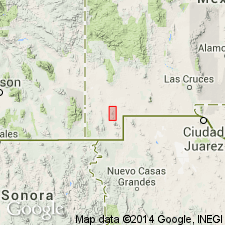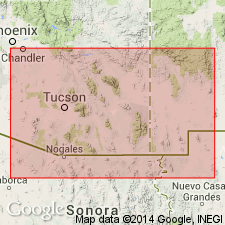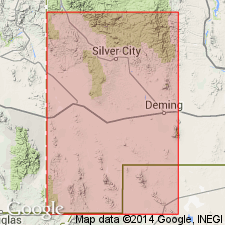
- Usage in publication:
-
- Corbett sandstone*
- Modifications:
-
- Original reference
- Dominant lithology:
-
- Sandstone
- AAPG geologic province:
-
- Pedregosa basin
Summary:
Pg. 533-534, figs. 2, 4; USGS Prof. Paper 208, p. 23-24, pl. 1, 1947. Corbett sandstone of Bisbee group. Chiefly sandstone, in part quartzitic and massive, and variably black, brown, and white in color. Ripple marks and cross-bedding common. In part, the formation contains beds of shale that alternate with the sand and range from 1 to 15 feet in thickness. Includes several limestone members in eastern part of Eureka section. Thickness is 4,000 feet in Sylvanite section, where full original thickness is present, and ranges from 1,500 to 3,000 feet in Eureka section. Disconformably underlies Playas Peak formation (new) and conformably overlies Howells Ridge formation (new), both of Bisbee group. Fossils (marine pelecypods and gastropods). Age is Early Cretaceous (Trinity).
Named from Corbett Ranch at Granite Pass [Granite Gap?, in sec. 15, T. 29 S., R. 16 W.], Sylvanite district, Little Hatchet Mountains, Hidalgo Co., southwestern NM.
Source: US geologic names lexicon (USGS Bull. 1200, p. 938).

- Usage in publication:
-
- Corbett Sandstone*
- Modifications:
-
- Age modified
- AAPG geologic province:
-
- Pedregosa basin
- Basin-and-Range province
Summary:
Is formation in Little Hatchet Mountains, Hidalgo and Grant Cos, AZ in the Pedregosa basin and Basin-and-Range province. Is not considered part of Bisbee Group; changed from previous work by Lasky (1947). Bisbee Group not used locally in this paper. Conformably overlies Howells Ridge Formation (Lower Cretaceous). Thickness (following Lasky, 1947) about 4,000 ft. Is correlated with lithologically nearly identical lower 4,000 ft of Mojado Formation of Zeller, Jr. (1965) in Big Hatchet Mountains, and with Cintura Formation (Albian, Lower Cretaceous) in southeastern AZ. Age refined from Early Cretaceous (Lasky, 1947) to Albian (Fredericksburg and Washita), Early Cretaceous on basis correlation with post-Trinity age units. [See fig. 5 for regional correlation.]
Source: GNU records (USGS DDS-6; Denver GNULEX).

- Usage in publication:
-
- Corbett Sandstone
- Modifications:
-
- Not used
- AAPG geologic province:
-
- Pedregosa basin
- Basin-and-Range province
Summary:
Replaced by Mojado Formation. [Because of the faulted duplication of the Cretaceous sequence as defined by Lasky (1938) in the Little Hatchet Mountains and the resultant confusion about the relations of those units, probably most of them, including Corbett Sandstone, should be replaced by the better-defined and more widely used units of Zeller (1970).] Is of Early Cretaceous age.
Source: GNU records (USGS DDS-6; Denver GNULEX).
For more information, please contact Nancy Stamm, Geologic Names Committee Secretary.
Asterisk (*) indicates published by U.S. Geological Survey authors.
"No current usage" (†) implies that a name has been abandoned or has fallen into disuse. Former usage and, if known, replacement name given in parentheses ( ).
Slash (/) indicates name conflicts with nomenclatural guidelines (CSN, 1933; ACSN, 1961, 1970; NACSN, 1983, 2005, 2021). May be explained within brackets ([ ]).

